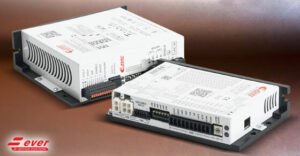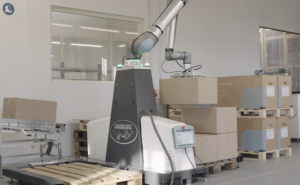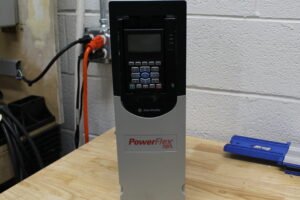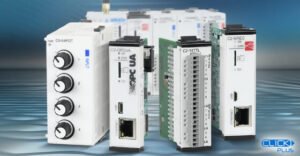In today’s rapidly evolving digital landscape, modernizing legacy systems is an essential business imperative. For many industrial firms, legacy motion control systems are seen as holding back their initiatives and industrial processes. This is because legacy systems are generally inefficient, inflexible, costly to maintain, less secure, and ill-suited to meet the demands of present-day automation applications, such as lower operating costs with higher performance, application versatility, and greater efficiencies.
As a result, manufacturers are continuously developing new automation technologies and innovative motion-control components that can retire legacy systems, allowing migration to more efficient, agile, and cost-effective solutions. One such solution is the Allen-Bradley 1336 Plus II AC drive series, discussed in this article.
The 1336 Plus II
The Allen-Bradley 1336 PLUS II is a complete line of compact and high-performance adjustable frequency AC drives from Rockwell Automation. Available in power ratings ranging from 0.5 to 600 Hp (0.37 to 448 kW) and three input voltage ranges: 200 to 240V AC, 380 to 480V AC, and 500 to 600V AC, this AC drive series helps provide an exclusive solution for precise motor speed control in different industrial applications, including material handling, smart conveyors, pumps, machine spindles, and fans. With a common design structure across the entire power range, coupled with interchangeable communication options and control interface functions, the 1336 PLUS II Series also provides users with a tremendous advantage in system design, operator training, component integration, and system maintenance.
The 1336 PLUS II series offers the following drive ratings:
- 0.5 to 125 Hp/0.37 to 93 kW at 200 to 240V AC
- 0.5 to 600 Hp/0.37 to 448 kW at 380 to 480V AC
- 1 to 600 Hp/0.75 to 448 kW at 500 to 600V AC
In addition, 1336 PLUS II drives are microprocessor-controlled variable frequency drives that offer user-selectable Sensorless Vector Control (SVC) or Volts-per-Hertz (V/Hz) operation with programmable functions, providing outstanding motor control. They use variable PWM (Pulse Width Modulation) frequency and modifiable drive output voltage to provide accurate digital speed regulation and excellent torque control. Using an Auto-tune feature, the output voltage of these drives can be tuned to deliver optimum torque performance for practically any load condition. The drives also feature an innovative design that provides exceptional operational integrity and reliability when controlling three-phase AC motors.
1336 PLUS II Drive Features
Allen-Bradley 1336 PLUS II AC drives are available with the following features and functions:
Serial Communications Options
- RS-485/422/232: These are user-specific DFI to DH-485 communication protocols.
- Single-drop Remote I/O: A local area network designed to connect 1336 PLUS II AC drives to Allen-Bradley PLCs and SLC 500 processors. The network allows discrete and full block data transfer in link mode.
- Flex I/O to SCANport (Catalog No. 1203-FM1): This communication module is available with all 1336 PLUS II drive ratings.
- DeviceNet to SCANport Module: All 1336 PLUS II drives do support this communication module.
- Allen-Bradley SLC to SCANport (Catalog No. 1203-SM1): The module provides a communication interface between any SLC 500 processor and a maximum of three 1336 PLUS II VFDs that support SCANport communications.
Selectable Motor Control Modes
Allen-Bradley 1336 PLUS II AC drives are configurable for Volts-per-Hertz (V/Hz) or Sensorless Vector Control (SVC) operation.
Volts-per-Hertz: The V/Hz control scheme regulates the speed of an AC motor by maintaining a constant ratio between the input voltage and frequency applied to the motor. It’s a simple and cost-efficient technique for controlling the speed of AC induction motors using AC drives or VFDs. Benefits of employing V/Hz control include smoother motor startups, constant torque capabilities over a wide speed range, and the ability to control multiple AC motors with just one VFD.
1336 PLUS II VFDs offer a fully programmable Volts-per-Hertz control mode that ensures unmatched motor performance in applications requiring control of multiple AC motors on a single drive, especially in cases where those motors are not identical in size and type. For instance, V/Hz mode can be used when controlling a 3.7 kW (5.0 Hp) and 11.0 kW (15.0 Hp) motor with a 15.0 kW (20.0 Hp) 1336 PLUS II drive.
Sensorless Vector Control: This is a technique for controlling the speed and torque of AC motors without using physical sensors (e.g., velocity or position sensors) for feedback. It is based on the relationship between the voltage, flux, and frequency of the AC supply to the motor. In SVC mode, the amplitude, phase, and frequency of the AC supply to the connected motor are regulated to maintain the speed of the motor as desired. It provides improved speed regulation and has the capacity to provide high starting torque. Other benefits of using Sensorless Vector Control include high energy efficiency, independent torque and speed control, improved system efficiency, reduced power consumption, and lower overall system costs.
1336 PLUS II AC drives configured for Sensorless Vector Control offer these performance enhancements:
- A user-programmable fast flux-up mode that assists in controlling the acceleration of large AC motors
- Better acceleration control allows even the toughest motor loads to be moved with ease, as it can provide a maximum of 250% acceleration/breakaway torque
- Outstanding system performance is possible if the drive setup parameters are programmed with the actual values on the motor’s nameplate
- Rapid acceleration mode that provides the least possible motor acceleration time for low-inertia motor loads. This is accomplished when the Adaptive Current Limit (ACL) feature is disabled.
- Exceptional low-speed torque output at low motor speeds as 15 RPM, delivering a 120:1 constant motor torque-speed range
Multiple Special Functions
- Auto Economizer: This function integrates stator flux control with a 1336 PLUS II economizer routine to enable end users to cut back on energy usage. When enabled, it continuously monitors the drive current, comparing it against the user-specified drive full-load (overload) amps. In load conditions where the motor’s actual current draw is substantially less than the specified overload/full-load amps, the 1336 PLUS II AC drive will automatically start decreasing the voltage output to the connected AC motor. This will minimize the magnitude of the flux current in the lightly loaded motor, resulting in reduced power (kW) usage.
- Auto-tuning: The auto-tuning feature in a 1336 PLUS II AC drive measures the motor’s no-load current, inductive reactance, stator and rotor resistance, and impedance. It then uses the measured parameters to adjust the configured motor control algorithm (V/Hz or SVC), enabling the drive to accurately regulate the motor speed and control the connected load. It is especially useful in open-loop control.
- Process PI Controller: With the 1336 PLUS II Proportional-Integral (PI) gain adjustments plus output clamping, error inversion, integrator reset, and feedback scaling functions, simple process control involving monitoring feedback signals and tuning drive output based on the feedback requirements is possible.
The aforementioned functions enable the Process PI feature to regulate the output of a 1336 PLUS II AC drive as per the PI feedback and PI setpoint (reference). If the included feedback device (e.g., an encoder) shows that the industrial process being controlled is deviating from the defined setpoint, the Proportional-Integral software will respond by modifying the drive output up until the PI feedback equals the setpoint again. Selectable PI inputs provide “manual/auto” capability for open-loop threading applications,while programmable PI preloads and presets ensure smooth transitions.
- Step Logic: 1336 PLUS II AC drives can be programmed to execute time, encoder feedback and pulse input counts, and digital input logic steps using or without requiring a programmable controller. Note, the Step Logic function is selected as an End Fault or a continuous loop.
- Traverse Function: The output frequency of a 1336 PLUS II AC drive can be easily programmed to modulate around a preset frequency. This is achieved by programming Max Traverse, Traverse Period, and P Jump parameters to develop a triangular waveform that is compensated for by inertia. In surface-driven winding operations, the developed triangular waveform can be used by traverse 1336 PLUS II drives to implement the traverse function electronically.
Protective Features
- Detection and Trip: 1336 PLUS II drives include motor protective features that detect fault conditions and trip to protect the connected motors from damage. Detectable fault conditions include overvoltage, drive overcurrent, Undervoltage, drive output short, load loss, external high-frequency signals, single phase, encoder loss, and ground fault.
- Overcurrent Stall Protection: 1336 PLUS II drives incorporate an external motor thermo-switch or an instantaneous overload (O/L) relay element that provides stall protection. An overcurrent stall happens when the AC motor drive stops abruptly due to an overload current. Tripping occurs when the overcurrent condition persists for a longer duration than the specified time value on the stall timer. Note that the overload protection offered by the external O/L relay is redundant to the inbuilt electronic overload protection that is integral to all 1336 PLUS II AC drive ratings.
- Overvoltage Stall Protection: This is a protective measure in 1336 PLUS II drives that prevents connected motors from stalling due to an overvoltage condition, which occurs when the output frequency to the motor changes faster than the motor speed – often caused by a sudden load loss. A 1336 PLUS II drive with this feature enabled will automatically regulate its operating frequency when its bus voltage reaches a specific level to prevent an overvoltage condition and subsequent motor stalling.
- Fault Reset Input: The function allows a 1336 PLUS II AC drive to clear a configuration error or fault condition due to overtemperature, loss of communication, Undervoltage, or overvoltage and resume normal operation.
- Motor Overload Protection: All 1336 PLUS II drive ratings include an inbuilt electronic motor I2t (overload) protection system that is isolated from the drive’s power overload feature. The system operates independently to provide enhanced Class 10 motor protection with speed-sensitive response.
Benefits of Using 1336 PLUS II Drives
Real-time Fault Diagnostics
Allen-Bradley 1336 PLUS II VFDs have inbuilt fault diagnostic systems that incorporate six drive alarms and reporting techniques for fault conditions like drive overcurrent, AC input undervoltage/overvoltage, drive overload, bus overvoltage/Undervoltage, motor overload, or line transients. As a result, the operator is alerted of alarm conditions before a drive fault occurs. Should the alarm condition reach a fault level, the AC drive sends out plain-language diagnostic messages via supported communication channels. These messages help maintenance teams to promptly identify and isolate the issue, allowing implementation of quick and effective corrective actions.
Based on the configuration settings of an individual 1336 PLUS II VFD, the fault conditions and drive status can be reported in real time through supported SCANport communications or via the included 1336 PLUS II Human Interface Module. Fault diagnostics are initiated on every occasion the 1336 PLUS II AC drive is started up. And throughout its entire sequence of operation, the drive will keep on looking for probable fault conditions. This allows for real-time preventive drive maintenance.
Simplicity
The simplicity of designing and programming 1336 PLUS II VFDs is evident in the following:
- Compact packaging options that allow for easy wiring, mounting, and installation of 1336 PLUS II AC drives in different types of industrial applications
- Interchangeable assembly modules that minimize the need to stock large quantities of 1336 PLUS II drive system components
- An easy-to-read, 2-line 16-character Supertwist backlit LCD interface that provides a multi-lingual display of drive status, programmed parameters, and faults, allowing simplified drive programming and performance monitoring
- Easy-to-program and easy-to-access drive parameters that are arranged in an element structure and groups of related functions
- Simple tuning of drive output voltage for optimal torque performance
Outstanding Motor Performance
Allen-Bradley 1336 PLUS II AC drives include powerful motor control algorithms – Sensorless Vector Control with slip compensation & full tuning and selectable Volts-per-Hertz with slip compensation & complete capability for user customization. The algorithms provide unparalleled motor performance, characterized by high starting and running torque of up to 250% in combination with 120:1 constant motor torque-speed range, low-speed motor torque, and improved acceleration control. These performance enhancements enable 1336 PLUS II AC drives to handle tough industrial applications that other AC drives can’t.
Application Flexibility
1336 PLUS II AC drives come with configurable control inputs and outputs that allow for simple connections to many user-defined control schemes. Also, 1336 PLUS II control I/O interface options are available, and they can be programmed to meet virtually every motor speed and torque control requirement.
In addition, 1336 PLUS II drives use digitally programmable functions, including DC injection braking, slip compensation, proactive current limit, dynamic braking, flying start, seven preset speeds, dual deceleration/acceleration profiles, event fault memory, and three skip frequencies. These functions enable the drives to execute precise and consistently accurate motor control in all types of applications. Note, 1336 PLUS II drives can be programmed locally for different applications via an RS-485/422/232 serial port, a SCANport communications interface, or from the 1336 PLUS II Human Interface Module using PC-based programming software, Allen-Bradley PLCs, or SLC 500 processors.
The 1336 PLUS II Drives come in all different configurations and we understand that it might be a headache to pick the right one. Thankfully, it doesn’t have to be with our team of specialists ready to help you find the perfect 1336 PLUS II for your automation solution. Give us a call today to elevate your automation system!














Post Comment